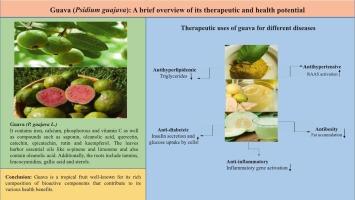番石榴(Psidium guajava):简要概述其治疗和保健潜力
IF 8.2
1区 农林科学
Q1 CHEMISTRY, APPLIED
引用次数: 0
摘要
番石榴(Psidium guajava)因其多种药理特性而长期受到重视。这种植物的叶子、果实和树皮中含有生物活性化学物质,这增强了其治疗用途的潜力。目的对番石榴的药理特性进行综述,重点介绍其抗炎、降压、抗肥胖、抗氧化、止泻和抗糖尿病的特性,以及其治疗牙病和提高体内血红蛋白水平的能力。方法为了评估番石榴的潜在健康益处,对其进行了全面的体外研究和体内临床研究。结果番石榴具有较强生物活性的主要原因是其黄酮。它在治疗不同疾病中的应用是有证据支持的。将其纳入功能性膳食的药用潜力令人鼓舞。结论番石榴具有广泛的治疗作用和丰富的营养成分。尽管临床前研究看起来令人鼓舞,但仍需要更多的人体试验来确认疗效、优化剂量并保证长期使用的安全性。本文章由计算机程序翻译,如有差异,请以英文原文为准。

Guava (Psidium guajava): A brief overview of its therapeutic and health potential
Background
The guava (Psidium guajava) has long been valued for its variety of pharmacological characteristics. The plant has bioactive chemicals in its leaves, fruit, and bark, which enhance its potential for therapeutic use.
Objective
The goal of this review is to compile the most recent information on the pharmacological properties of guava, with an emphasis on its anti-inflammatory, anti-hypertensive, anti-obesity, antioxidant, antidiarrheal and antidiabetic properties as well as on its ability to treat dental diseases and increase haemoglobin levels in body.
Methods
To assess the potential health benefits derived from guava, a thorough review of it in vitro, and vivo clinical investigations was carried out.
Results
The main cause of guava's strong bioactivity is its flavonoids. Its application in the treatment of different diseases is supported by evidence. The medicinal potential of its inclusion in functional meals is encouraging.
Conclusion
The guava fruit has a wide range of therapeutic properties and is rich in nutrients. More human trials are needed to confirm efficacy, optimize dosage, and guarantee safety in long-term usage, even though preclinical research appears encouraging.
求助全文
通过发布文献求助,成功后即可免费获取论文全文。
去求助
来源期刊

Food Chemistry: X
CHEMISTRY, APPLIED-
CiteScore
4.90
自引率
6.60%
发文量
315
审稿时长
55 days
期刊介绍:
Food Chemistry: X, one of three Open Access companion journals to Food Chemistry, follows the same aims, scope, and peer-review process. It focuses on papers advancing food and biochemistry or analytical methods, prioritizing research novelty. Manuscript evaluation considers novelty, scientific rigor, field advancement, and reader interest. Excluded are studies on food molecular sciences or disease cure/prevention. Topics include food component chemistry, bioactives, processing effects, additives, contaminants, and analytical methods. The journal welcome Analytical Papers addressing food microbiology, sensory aspects, and more, emphasizing new methods with robust validation and applicability to diverse foods or regions.
 求助内容:
求助内容: 应助结果提醒方式:
应助结果提醒方式:


